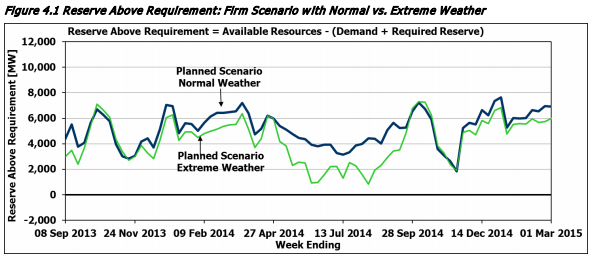"The IESO is constantly looking for ways to improve the efficient operation of the province's electricity market, while promoting continued reliable supply," said Bruce Campbell, President and Chief Executive Officer of the IESO.Uh-huh
A quick look at "efficiency" from the numbers within the forecast itself.
In working on a tool to support planning a supply mix, I concentrated on what the IESO refers to as "Forecast Capability at Peak" - which is an important figure in meeting reserve requirements above demand.. This is more of a concern in the summer because some generation is less productive (wind especially) and demand peaks have been air conditioning driven.
The annual demand peak the past 4 years have been relatively close at 25075MW, 25450MW, 24636MW and 24927MW.
In table 4.4 the IESO claims a "Normal Weather Demand" peak of 22,282 MW for 2013 (actual is 24,927), and in table A1 of the IESO's complimentary spreadsheet, the 2014 summer peak for "normal" weather is 22,834.
Normal peak would seem to be ~2000MW above that - the addition on solar capacity and demand response might have an impact, but not that much of an impact.
It looks suspicious - as if the system operator is meeting reserve requirements by redefining a normal, and much lower, peak summer demand.
The IESO presents a listing of "Committed and Contracted Generation Resources" in Table 4.2, with both "Firm" capacity changes (negative 2,740MW) and planned ones.
Planned projects of 3273MW capacity are comprised of 2574MW of wind capacity, 280 of solar, 212 of water and 205 of biomass. This references only projects not embedded with LDC's, and the IESO states in the document plan is for "more than 3,800 MW of grid-connected renewables added to the system."
What difference does the 3800 MW of planned, primarily wind and solar, capacity make in terms of meeting reserve requirements?
It doesn't really matter if 4.1 is mislabelled as the "firm" scenario while graphing the planned scenario or not - the difference to the reserve above requirement is minimal during the peak summer period.
And the peak is suspiciously low.
Of course the burgeoning wind turbine capacity - unhindered by intelligent government stopping/delaying it - is not meaningless in all ways, but only in terms of providing needed capacity to meet peak demand.
It's very meaningful in adding to periods of too much supply - which is how "efficient operation" comes to be a term applied to increasing the pool of suppliers that can be paid not to supply.
This 18-Month outlook concludes, as many have before, on the periods of too much supply (surplus baseload generation):
Ontario will continue to experience an increase in volume, frequency and duration of SBG conditions with declining wholesale demand for electricity and significant quantities of baseload generation on the system. However, the vast majority of SBG is managed through normal market mechanisms including exports and nuclear maneuvering. The IESO will gain another tool to help manage SBG as grid connected wind becomes a dispatchable resource in Q3 2013.



C8B6160FFF
ReplyDeletehacker kirala
hacker kiralama
tütün dünyası
-
-
8810FDCAD0
ReplyDeleteinstagram takipçi
accent chair swivel